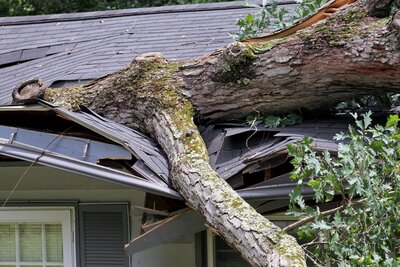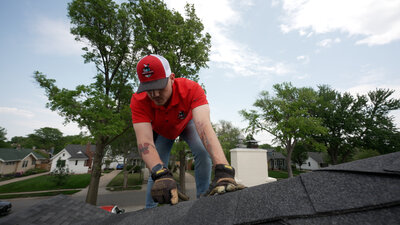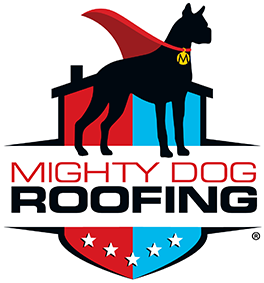5 Steps to Getting Insurance to Pay for Your Roof Replacement
Table of Contents
- Step 1: Document the Roof Damage
- Step 2: Review Your Insurance Policy and Call Your Agent
- Step 3: File A Claim Immediately
- Step 4: Schedule an Inspection with Your Adjuster and Roofer
- Step 5: Replace Your Roof
- 4 Tips for a Smooth Roof Replacement Insurance Claim
- Frequently Asked Questions
- Call Today to Book a Free Roof Inspection!
Are you worried about the cost of a new roof after a storm? We understand the stress that comes with roof damage. Navigating the insurance claim process for a new roof can feel overwhelming, but it doesn't have to be.
This guide will help you get insurance coverage for a legitimate roof replacement. We'll discuss the different types of coverage, what's typically covered (such as hail, wind, or fallen trees), and how to file a claim.
Remember, insurance covers specific types of damage (like hail, wind, or fallen trees). This guide is for legitimate claims only.
Step 1: Document the Roof Damage

Grab your camera or phone to document all visible roof damage.
Focus on cracked or missing shingles, dents in metal flashing, granule loss on asphalt shingles (often indicating hail damage), and any signs of leaks or water intrusion.
Hail damage often appears as small, circular dents or dings. Take both close-up shots and wider shots for context. Note the date and time you took the photos and when you believe the damage occurred. This documentation is crucial for your claim.
Step 2: Review Your Insurance Policy and Call Your Agent
Dust off your insurance policy and give it a thorough read. Understanding your coverage is key.
Understanding The Types Of Roof Coverage
Roof replacement coverage protects your home from the costs of repairing or replacing your roof. Three main types of roof replacement coverage are available: actual cash value, roof replacement cost, and extended replacement cost.
Actual Cash Value
Actual cash value coverage reimburses you for the depreciated value of your roof and gutters.
For example, if your roof is 10 years old and needs to be replaced, your insurance company will reimburse you for the depreciated value of your roof. This type of coverage is typically less expensive than roof replacement cost or extended replacement cost coverage.
The benefit of having actual cash coverage value is that you will not have to pay out of pocket for the initial cost of replacing your roof, as the payout is often reasonably quick. However, the downside is that you will not be reimbursed for replacing your roof.
Replacement Cost Coverage
Roof replacement cost coverage reimburses you for the actual cost of replacing your roof rather than only paying for the depreciated value of your home's roof.
Because this type of coverage pays for the entire cost of replacing the roof, it is more expensive than actual cash-value coverage, which pays only for the depreciated value.
The benefit of roof replacement cost coverage is that you will not have to pay anything out of pocket for replacing your roof, also known as a deductible. If you do end up paying some of the cost out of pocket for a damaged roof, you will be reimbursed for those costs. The downside is that this type of coverage is more expensive than actual cash-value coverage.
Extended Replacement Cost Coverage
Extended replacement cost coverage is an optional insurance add-on that pays for 10% to 50% more than the cost of replacing your roof.
This insurance type covers unexpected labor, higher-than-normal costs for roofing materials, or construction costs that increase due to natural disasters or other complications. By paying for this insurance, homeowners ensure they are not surprised when a roof replacement project costs more than initially anticipated.
The benefit of extended replacement cost coverage is that homeowners do not have to pay out of pocket to replace their roofs, even if the replacement costs more than the original cost.
However, one con for paying for extended replacement coverage is that recurring insurance costs are higher than actual cash-pay coverage or replacement cost coverage.
Call Your Insurance Agent
Don't hesitate to contact your insurance agent. They can explain the specifics of your policy and advise you on whether filing a claim is the best course of action. They can also give you an idea of what to expect from the claims process.
Calling your agent does not mean you are filing a claim. You're simply discussing your situation and getting their advice on the best action.
Step 3: File A Claim Immediately
The next step is to file a claim with your insurance company. It is crucial to open a claim quickly because most insurance companies have a time limit within which you must file a claim. Most policies require you to file a claim within 30 days of the incurred damage.
If you wait too long to file a claim, your insurance company may deny your claim outright. So, file your claim promptly to ensure your damage is covered.
Step 4: Schedule an Inspection with your Adjuster and Roofer

Your insurance company will assign a claim adjuster to inspect the damage.
Be present during this inspection. Point out all areas of concern and share your documentation. The adjuster will be your main point of contact throughout the claims process.
You should have a reputable roofing contractor present during the adjuster’s inspection. Most adjusters are generalists, not roofing specialists.
A qualified contractor can identify subtle damage that an adjuster might miss. This combined inspection ensures everyone is on the same page. Most adjusters don't know as much about roofs as a roofing company.
At Mighty Dog Roofing, we offer free drone roof inspections. Our roof inspectors provide detailed visuals of your roof's condition, which are valuable for your claim. This level of transparency can significantly aid in a smooth claim experience.
Step 5: Roof Replacement
You can begin the roof replacement process based on the adjuster's assessment and the agreed-upon scope of work.
Once the work is complete, your insurance company will typically pay your contractor or you directly.
Consider Waiting To Repair Your Roof Until The Claim Is Approved
Once you have submitted your claim and documentation of the damage to your insurance company, you will need to wait for the claim to be approved before proceeding with repairs.
Although it may be tempting to go ahead and repair your roof as soon as possible, you should consider waiting until the claim is approved.
It's best to wait until your insurance claim is settled before starting roof repairs or replacement. Otherwise, you risk paying for work your insurance might cover, especially if they require you to use their preferred contractor.
4 Tips for a Smooth Roof Replacement Insurance Claim
Continue reading to learn about three ways to have a smooth roof replacement claim process.
Tip 1: Consult Only Reputable Roofing Contractors
When it comes time to repair your roof after storm damage, consult only reputable roofing contractors. This will help ensure that you are getting a quality job and that you are not taken advantage of by a contractor looking to make a quick buck.
Take caution if a contractor comes to you after a major storm and asks to repair your roof. You may be talking to a "roof storm chaser". A roof storm chaser is someone who goes into areas that have been affected by a major storm and tries to get business from homeowners.
These contractors are often unreputable and may do poorly on your roof. They may also try to commit an insurance scam by telling you that your insurance company sent them or that the company will reimburse you for the bill.
So, before proceeding with repairs, consult only reputable roofing contractors and get more than one estimate.
Tip 2: Know What Kind Of Roof Damage Is Covered By Insurance
It is important to know what kind of roof damage is covered by insurance to file a claim when necessary. Storms, hail, fire, wind, and fallen tree limbs are typically covered.
Storm Damage
Storm damage, including hail damage, is one of the most common types of damage to a roof.
Most homeowners insurance policies cover storm damage, including tornados, hail, snow, hurricanes, and freezing rain. However, it is essential to check with your insurance company to ensure that your policy covers a hail storm or accidental damage.
If your roof is damaged because of a storm, it is important to file a roof claim as soon as possible. Your insurance company will send an adjuster, or the insurance adjuster may hire a professional inspector or roofer. They will inspect the damage and determine if it was pre-existing damage or a lack of maintenance to determine the cost of repairs or replacement for wood roofs, metal roofs, or asphalt shingles types of roof.
Fire Damage
Fire damage is another common type of damage that is typically covered by a standard home insurance policy.
Several mishaps can cause fire, such as a cigarette, lightning, putting tinfoil in the microwave, catching aprons on fire from a gas oven, or even an electrical fire. Therefore, it is wise to take precautions to avoid fires, such as not leaving candles unattended, not smoking in the house, and ensuring that your electrical wiring is up to date.
While most homeowners' insurance policies cover fire damage, some do not. It is essential to check with your insurance company to see if your policy covers fire damage in the dwelling coverage. You may consider adding this coverage to your policy if it does not.
If your roof is damaged by fire, you should submit a claim as soon as feasible to obtain the appropriate reimbursement. As with storm damage, your insurance provider will dispatch an adjuster to examine the damage and roof features like missing shingles and the roof's age and assess the cost of repair or replacement.
Wind Damage
Wind damage is another type of damage that is typically covered by homeowners' insurance policies.
Wind damage can be caused by several things, including hurricanes, tornadoes, and even high winds from thunderstorms called straight-line win
ds. Insurance policies also sometimes cover siding and windows. However, it is important to read your policy and understand exactly how much coverage is offered for several types of windstorms so that you do not find yourself under or over-insured for any subsequent damage from wind.
As with fire and storm damage, if your roof is damaged by wind, you should file a roof insurance claim as soon as possible to get the compensation you deserve. After you have filed a claim, an adjuster will be sent to your home to inspect the damaged areas and determine the cost of repairs or replacement.
Fallen Tree Limbs
Another type of coverage typically offered by homeowners' insurance is fallen tree limb coverage.
This type of coverage is important because trees can become brittle and break easily as they age, especially during severe weather conditions. A tree limb that falls on your roof can cause severe damage.
Most insurance policies will cover the cost of repairs if a tree limb falls on your roof. However, some will cover only a portion of the repair costs, and some will cover costs only under certain circumstances. Therefore, you should check with your insurance company to see what type of coverage is offered for this type of damage.
Additionally, when you get a homeowner policy, they will sometimes require dangerous tree limbs to be cut to avoid limbs falling on your house. Be sure to comply with these measures for any additional roof coverages.
Tip 3: Know Damages Insurance Generally Doesn't Cover
Insurance does not cover some types of damage. These include damage caused by disasters such as floods or earthquakes or by improper installation.
Improper Installation
One type of mishap that insurance does not typically cover is improper installation.
If your roof is not installed correctly, your insurance policy can be voided. In other words, insurance companies will deny replacement if they find that the roof was installed improperly, even if it has suffered storm damage.
Consequently, you want to be sure your roof is stable and properly built before the stormy season and before any other wear and tear occurs.
Having a properly installed roof is why it is so important to hire a qualified and licensed contractor to do the installation. Additionally, be certain that you get everything in writing and that you understand the roof's warranty measures before signing the paperwork.
Tip 4: Prepare For Future Roof Damage
Numerous events and mishaps can damage your roof. Consequently, it is extremely beneficial to prepare for future roof damage.
So, maintain records of previous roof inspections, take yearly photos of your roof, and use an installer who offers a workmanship guarantee.
Maintain Records Of Roof Inspection
One way you should consider preparing for roof damage is by maintaining records of your roof inspections.
You should keep a history of your roof in case you need to file an insurance claim in the future.
Some roofing companies, such as Mighty Dog Roofing, offer this service to their clients. Consider signing up for this service for an accurate and up-to-date record of your roof's condition. This will help you prepare for any mishap, natural disaster, or other unexpected event that damages your roof.
Take Photos Of Your Roof Each Year And Immediately After Damage
Another way to prepare for potential roof damage is by taking yearly photos of your roof.
These photos can be helpful in a few ways:
- First, if your roof is damaged, the pictures can be documentation for your insurance company.
- Second, even if your roof is not damaged, the pictures can help you identify potential issues before they become more significant problems.
- Finally, the photos can prove that the roof's damage resulted from a storm rather than a problem that had existed before the storm or disaster.
Like maintaining records, Mighty Dog Roofing offers annual roof inspections. For a small fee, we will come out once a year and take pictures of your roof. This way, you will not have to worry about getting up on your roof and can be sure the job will be done carefully and precisely.
Find A Roofing Installer With Warranties
Finally, choose a roofer who offers warranties. A warranty can protect you from paying high fees for damage that could happen in the future.
This will protect you in case there are problems with the installation of your new roof or if you need to have your old roof replaced or repaired.
Finding an installer with a workmanship guarantee ensures that you will not have to pay for any damage caused by a problem with the installation or workmanship.
Mighty Dog Roofing offers a five-year Mighty Watchdog Warranty. With us, you can be sure you get a quality job when using our services.
Frequently Asked Questions
How much will my insurance pay for a roof replacement?
Insurance typically covers the cost of replacing a roof damaged by a covered peril, such as a storm or fire.
However, the exact amount they pay depends on several factors:
- Your Policy. Your specific insurance policy dictates your deductible and what's covered. Review your policy or contact your insurance agent for details. Replacement cost value (RCV) policies will pay the full cost of a new roof (minus your deductible). Actual cash value (ACV) policies pay the depreciated value of your old roof.
- Extent of Damage. Insurance adjusters assess the damage to determine whether a repair or complete replacement is necessary. They document the damage and estimate the cost.
- Deductible. You'll be responsible for paying your deductible before the insurance coverage kicks in. This amount will be deducted from your claim payout.
- Roof Age and Condition. While insurance covers damage from covered damage, it doesn't cover wear and tear. If your roof was already in poor condition, the payout might be less.
It's crucial to contact your insurance company immediately after discovering roof damage. Document the damage with photos and videos, and be prepared to provide information about your roof's age and condition. A qualified roofer experienced with insurance claims can make the process much smoother.
Is roof insurance included or supplemental?
Roof coverage is typically included in a standard homeowners insurance policy. It's not a supplemental or separate policy you buy. It's part of the coverage for your dwelling (the structure of your house).
However, homeowners insurance generally doesn't cover damage caused by normal wear and tear, age, or lack of maintenance. Also, certain events like floods and earthquakes usually require separate policies.
It's always a good idea to review your policy. Also, talk to your insurance agent to understand exactly what types of roof damage are covered and what your specific policy details are.
What is the difference between damage coverage and replacement coverage?
Most homeowners' insurance policies cover damage. This coverage covers the cost of repairing or replacing a roof damaged by a sudden accident or act of nature.
Replacement coverage, on the other hand, covers the cost of completely replacing your roof, regardless of the cause of the damage. This type of coverage is typically more expensive than damage coverage, but it may be worth the cost if you live in an area that is prone to severe weather or if your roof is old and will need replacement soon.
Can you keep insurance money and not replace a roof?
Technically, you can keep the excess claim money from a roof repair.
However, keeping all the money and not replacing your roof at all depends on the circumstances and the insurance company. If you own your home completely, the insurance company will typically give you the money to repair the roof, even if you do not end up replacing the old roof.
Insurance companies might not give claim money directly to residents who do not own the home they are in free and clear. Instead, the insurance company may give the money to the mortgage lender or go straight to the roofing contractor and bypass you as the homeowner or resident completely.
So, check with your insurance company to find out what they allow you to do with the claim money and whether you will receive it directly.
Will insurance cover a 15-year-old roof?
Depending on the insurance company and your policy, most companies will cover roofs that are 15 years old. However, they will not simply cover any damage, especially to an older roof.
Oftentimes, your annual insurance premium will increase as the age of the roof increases. That way, insurance companies feel safer offering coverage that will cost the company a great deal of money. If, when buying or renewing an insurance policy, your roof is older than the company feels comfortable with, the insurer may decline your insurance request or refuse to renew your old insurance policy.
Call Today to Book a Free Roof Inspection!

Dealing with roof damage and insurance claims can be stressful, but you don't have to navigate it alone. This guide provides key information to help you understand your coverage and file a successful claim.
Do you need a free roof inspection after storm damage? We offer free inspections to ensure you receive the full coverage you deserve. Contact your local Mighty Dog Roofing team today to restore your peace of mind.


